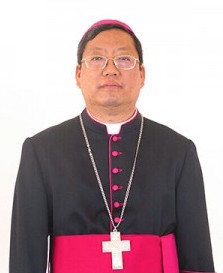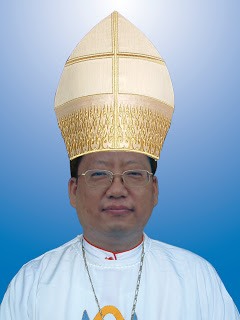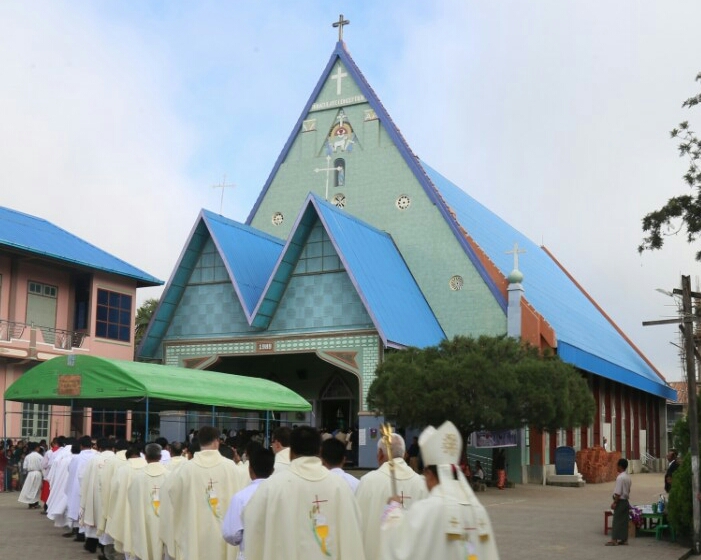

The Blue Mountains in the western side of Chindwin river were always on the mind of the French Priests of the “Parish Foreign Mission Society” (Missions Etrangeres De Paris). They were known for their missionary zeal and holiness. They attempted to enter the Chin Hills even in 1864. In that year Bishop Bigandet sent Fr. Lecamte (MEP), but his mission to reach the Chin hills was not successful since his movement was restricted. The king’s soldiers escorted him and did not allow him to go beyond the Catholic villages.

Twenty years later in 1884, Fr. Laurent (MEP), who worked some years among the Kachins previously, came to Kalaymyo. There he met some Chins. He found that the Chins did not speak much Burmese but they were kind and simple. In 1888, Fr. Antonin Usse came up to Kindat near Mawlaik from Chaung U by English steamer. Relating his experience, he wrote to Bp. Simon of Mandalay: “Farther in the west are the Chins, a people of straight forward and brave warriors, who are defending their independence against the ambition of the English, I would be proud to be their apostle”. He came back to visit the Catholics in the English military camps. This time, on September 22, 1889, he reached Forth White near Thuklai. As he looked down from there, he saw the nearby villages abandoned by the villagers who hid themselves in the jungle due to the war with the British soldiers. In his letter to the bishop dated October 15, 1889, he said: “Once I climbed up to the top of the mountain and contemplated the villages far away. How I wished to go there with my crucifix and my breviary …. it would be useless to go now. The country will open itself. Some day it will be necessary to send a caravan of missionaries in that part of the vineyard. They might die even there, victims of their zeal”. He was the first Catholic priest to visit Northern Chin State. In 1890, the Vicar Apostolic of Mandalay, Msgr. Simon, sent one of his best priests, Fr, Laurent ( MEP ) and Fr. Vestraeten to Chin Hills, 250 miles away. They went towards Northern Chin hills and settled at Balet, south of Mawlaik, on the western side of the Chindwin River. But after one year, they saw that they were still far-from the real Chins.

The next year, Fr. Laurent went with Fr. Jarre to enter Chin Hills in the South from Pakokku, through Pauk and Thilin. They arrived to the large village of Shon-Shi, near the Myittha River. Although it was at the foot of the hills, they had met with real Chins, and they began to study the language. At the end of 1891, after the retreat, a third missionary, Fr. Accarion, joined them. With the complicity of Chin traders who had come down to the plains, they made the project of climbing to Hakha to settle there, in the centre of Chin Hills, Fr. Laurent remained at Gangaw for health reasons. But as soon as Frs. Jarre and Accarion arrived to Hakha, the capital of Chin State, an English officer, who was a protestant and hostile to the Catholics, obliged them to leave the place and to go back down to the plains saying that Chins were not yet civilized and the life of the priests would be in danger. The Fathers had no choice but to go back to Gangaw. In 1898, the American Baptist missionaries came to Hakha. The same officer who refused to give permission to Catholic missionaries to work in the Chin Hills welcomed them with open arms.
The coming of the Baptist Mission was a blessing on disguise for the Catholic Mission. For more than forty years, they invented the written language of Hakha, Falam and Tiddim with Roman alphabets. They translated the New Testament. They abolished the sacrifices to the spirits which is too costly. The Chins opened their eyes to the world. They wanted to become Baptists, but their strict prohibition to drink “Zu” (Traditional Alcoholic Drink) is too demanding for the Chin people. “Zu” is for them a kind of nutrition and also the only consolation tor them after a hard day’s work. Many people began to ask for a kind of Christianity that would allow its believers to drink “Zu”. At the same time many wanted to be free from worshipping evil spirits. By any standard, the first attempts of Catholic missionaries to Chin Hills were not successful.
The Chin State was under the Archdiocese of Mandalay until Hakha Diocese was established on 21st November, 1992. Bishop Nicholas Mang Thang, ordained as Auxiliary Bishop of Archdiocese of Mandalay on 15th January, 1989, was appointed on 21st November, 1992 and enthroned on 21st March 1993 as the first ever Bishop of Hakha Diocese. Considering a better and more effective mission administration of the diocese, His Holiness Pope Benedict XVI raised Msgr. Felix Lian Khen Thang to the dignity of episcopacy and appointed him as Auxiliary Bishop of Hakha Diocese. His Episcopal Ordination was held on 6th May, 2006.
As the mission territory of Hakha Diocese was far distant and remote, and the number of the believers was increasing, another new diocese was prepared to be established soon. On 22nd May, 2010, the Holy Father, Pope Benedict XVI, created a new diocese, Suffragan to the Archdiocese of Mandalay, from the Diocese of Hakha and appointed Msgr. Felix Lian Khen Thang as the first bishop of the diocese and the Enthronement was held on 29th June, 2010, the Solemnity of Sts. Peter and Paul.
Kalay diocese is geographically located on the north-western part of Myanmar covering some part of the Chin State and part of Sagaing Division. It is bounded by the diocese of Myitkyina on the northeast, Mandalay on the east and Hakha on the south. It is approximately 8585.3 square miles with a civil population of 578557. The diocese comprises 3 townships of Chin State namely – Tedim, Tonzang and Cikha, and adjacent regions: Tamu, Kalay, Kalewa, Phaungbyin, Mawlaik. There are 22 parishes grouped into 4 vicariates or zones namely – Kalay, Khampat, Tiddim and Tonzang.
Under Kalay Vicariate, there are 7 residential parishes, namely: Kalay, Tahan, Kelewa, Mainuai, Inngyinkhone, Pyidawta, Kyar Inn and Sts. Peter & Paul.
Under Khampat vicariate, there are 4 residential parishes; Khampat, Tamu, Khumnuai, Sawbuayeshin.
Under Tiddim Vicariate, there are 8 residential parishes: Myoma-Tiddim, Sakollam- Tiddim, Saizang, Laitui, Tuithang, Heilei, Suangpi and Lailui.
Under Tonzang Vicariate, there are 3 residential parishes: Tonzang, Mualpi, Cikha.
We are a people of God with deep faith, living in peace and pros- perity, sharing with what we are and what we have.
To emerge from being an evangelized community to an evangeliziong community, and deliver civilization of love in truth to our neighbors.
1.To transform and renew our culture in the light of gosple values.
2.To promote the wholistic development of the people of Kalay Diocese through participatory approach.
Freely you have received, freely give (Mt. 10:8-9). It is more blessed to give than to receive (cf. Acts 20:35).